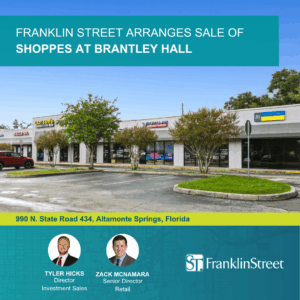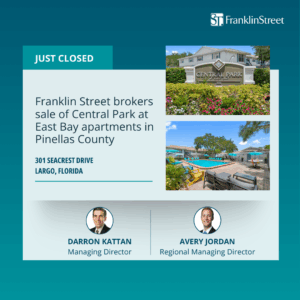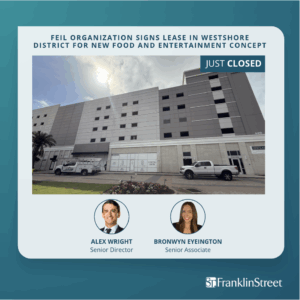What drew Ken Stoltenberg to Channelside more than a decade ago doesn’t sound so appealing in retrospect.
Part of the area’s allure was its position adjacent to Tampa’s central business district, a major employment hug. But what sealed the deal for the Tampa developer was the derelict warehouses dotting the landscape at that time. It was essentially a blank canvas for new development when Stoltenberg and his partner broke ground on Grand Central at Kennedy in 2005, a $145 million residential-and-retail project.
“Because it was, what’s the right word – such a dump – you could basically remake the whole thing,” he said.
Channelside has since evolved into a nascent urban neighborhood, home to thousands of apartments and condominium units as other developers followed in Stoltenberg’s footsteps, capitalizing on a Millennial appetite for density and walkability. But with traffic patterns suitable for highway speeds and few retailers within walking distance of the residential buildings, Channelside lacks the critical mass that creates vibrancy.
The have the kind of energy that defines signature neighborhoods in cities across the United States, Channelside must become a destination, a place with street-level energy that would attract enough residents and visitors for retailers to prosper.
It’s a dynamic that can be observed just across the bay in St. Petersburg, where a revitalized downtown waterfront has a cachet that’s recognized throughout the Southeast. Urban renewal efforts in St. Petersburg have created a sense of place that has spurred high rise development, destination restaurants and national and boutique retailers.
Channelside’s renaissance is approaching a tipping point, as Tampa Bay Lightning owner Jeff Vinik continues to work on plans for the 23.5 acres of land between the district and downtown Tampa that he’s spent the last year amassing. Details are scarce, but Vinik’s team has hinted as “Channelside Live,” a massive mixed-use development that could include office and retail space along with a hotel and residential buildings. In late July, Vinik also won control of Channelside Bay Plaza, the beleaguered waterfront mall that has struggled for years to retain the types of retailers that could draw in residents and tourists alike.
Tampa’s ever-evolving identity may rest on the execution of Vinik’s plans, as the evolution of Channelside into a vibrant urban neighborhood would be a boost to ongoing downtown revitalization efforts., which Mayor Bob Buckhorn champions as a tool for economic development, attracting the Millennial work force and the companies that follow it.
“This is something that can transform Tampa forever,” said Franklin Street CEO Andrew Wright, whose firm Vinik has tapped to oversee the leasing and management of Channelside Bay Plaza.
A neighborhood takes shape
Housing demand for the much sought-after Millennial work force has created boom times for apartment developers and investors in Tampa and nationally.
The thousands of residential units in Channelside are more than 90 percent occupied for a total population of 2,500 people, according to data from Tampa Downtown Partnership – astronomical growth when one considers there were about 500 people living in Channelside in 2007, and all of 11 people lived there in 2000, according to the partnership.
The 23-story, 320-unit apartment tower SkyHouse Chnnelside is under construction along 12th Street between East Washington and West Whiting streets. Stoltenberg is moving forward with his next project, a high rise retail-and-apartment development that could include a grocery store and a slew of swanky amenities, among them an eight floor clubhouse with 270-degree views of the city and a heated saltwater pool.
Developers wouldn’t be pursuing those luxury urban apartment deals if they weren’t able to command top-of-market rents, north of $2 per square foot. Those rents aren’t current seen in Channelside but are in nearby projects that would compete with the ones proposed, including The Element in downtown Tampa and Crescent Bayshore.
“Certainly, I think those rents support that there’s growing demand in that area,” said Seas Williams, a senior vice president with CBRE Group Inc.’s multifamily housing team in Tampa.
The residential boom has helped lure a few retailers to the area, with momentum mountin over the last two years.
On a Friday morning in late July, people in jeans and flip flops pounded away on laptop keyboards inside the rustic-chic Le Mouton Noir, a baker and coffee shop along Channelside Drive. Open for a few short months in Stoltenberg’s building, Maloney’s Irish Pub regularly draws an evening crowd. Fitness buffs, from yoga devotees to weightlifters, walk to and from the two gyms in the neighborhood, and dog owners take their four-legged companions for strolls through he small public art park in the courtyard at the Pierhouse apartments.
Retail activity is starting to pick up. There’s been chatter of Publix Super Markets Inc. coming to Channelside, possibly on the ground floor of Stoltenberg’s new project, for more than a year. Jason Donald, a director in Cushman & Wakefield of Florida Inc.’s retail group in Tampa, said he’s seeing more activity on the retail space in The Slade, for which he is the listing agent.
Most of that activity is from independent retailers looking for space – the area still lacks the density needed to draw national retailers.
“If you think, ‘Build it and they will come’ – we’ve built it, and they just haven’t come yet,” he said.
But all of those positives don’t quite add up to street-level energy – “that visceral feeling as you walk around,” Donald said. “I don’t think we have the connectivity or continuity inside Channelside to have that yet.”
Fixing ‘a dysfunctional corner’
That connectivity is exactly the issue Vinik’s group is looking to solve, Wright said.
Wright and other Vinik representatives stress that both the plaza and the downtown land Vinik has acquired over the last year are long-term projects that require months of planning and meeting with city and port officials, as well as public meetings to gather a sense of the community’s vision for the property.
But one thing that’s certain, Wright said, is the need to connect all the components. Vinik’s team envisions an entertainment district that spans from the Tampa Convention Center to the Florida Aquarium, with the Tampa Bay Times Forum as the centerpiece – and all of it will need to be connected to Channelside Bay Plaza.
“The property needs to be planned into the district, ” Wright said. “The reason it’s struggled, despite the fact you have all these great things, is that they’ve never been connected.”
Vinik’s plans have a powerful ally – BUckhorn, who sees them as a linchpin to downtown revitalization.
His vision for downtown, laid out years ago, is a “an urban environment that is water-centric” that capitalizes on the Hillsborough River running through the city center. Channelside’s issues include connectivity with the water – in Buckhorn’s vision for the area, the mall would be opened up to tie the neighborhood to the waterfront.
Without that kind of connectivity, Channelside, and especially the plaza, have been downtown Tampa’s “dysfunctional corner,” Buckhorn said.
“That’s the weak link in the chain,” he said. “Once we get that fixed, I think it will be a really powerful environment.”
But the issue isn’t as simple as taking a wrecking ball to the mall. Because the mall is so close to the Port Tampa Bay cruise terminal, Homeland Security restricts access to the waterfront behind the plaza. There’s been chatter for years about whether the cruise terminal could be moved elsewhere in the port or even to Pinellas County.
Buckhorn scoffs at comparisons to St. Petersburg’s downtown waterfront. If Vinik’s investment and the visions of success are realized, of course Tampa’s downtown will have that same kind of energy – but “on steroids,” he says.
“They’ve got a great niche with the arts and Beach Drive,” he said, “but that’s not who we are or who we aspire to be.”
Tampa, Buckhorn says, is the “000-pound gorilla, the economic engine that drives this region.”
Tampa’s status as an employment hub isn’t in dispute. But if Tampa doesn’t succeed at revitalizing Channelside and its urban core, it runs the risk of an all-work-no-play identity, while St. Petersburg continues to shine as the Bay area’s most vibrant destination. Download PDF



